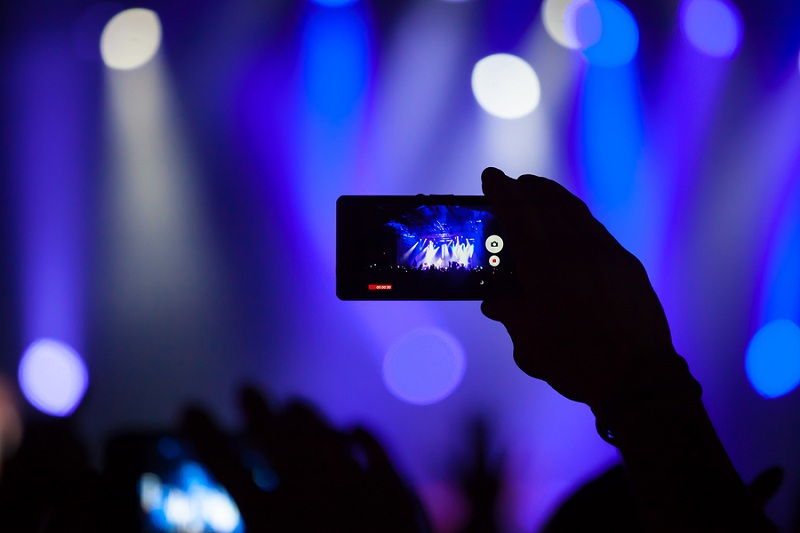© Corbin Ball & Co
These are exciting times. The rate of technology change is accelerating with thousands of ideas, apps and innovations bubbling up to help meeting planners, exhibitors, venues and other meeting participants to do their jobs better and improve the attendee experience.
This annual review covers many of the major events technology trends to watch for this coming year.
Social media channels are targeting events with a focus on video and live streaming.
Social channels are finding that events are a great way of gaining market share especially with streaming video. Nearly every social channel has added or enhanced their video offerings over the past two years.
We will see increased demands for live streaming events by attendees. The challenges for event planners will be increased Wi-Fi bandwidth demand. Also, the event host with deep pockets will be the likely target for copyright violation issues.
Data analytics will enhance the attendee experience and will greatly improve events.
The good news is that finally data management systems have matured to the point where data integration is a simpler task. With state-of-the-art cloud-based systems and robust, well-documented API’s it is now possible to collect and analyze data from a myriad of sources. As cloud-based systems get more powerful each year, big data tools are opening a new world of predictive analytics that can have huge impacts on events. In addition, machine learning and artificial intelligence (AI) tools are growing more powerful as well, helping to sort through this blizzard of data.
Engagement becomes an increasingly key component to events.
The ROI of an engaged attendee is simple: attendees who are emotionally involved/committed get more out of the event. They learn and retain more. They are more interactive. They bring out more in others. They will like rate the event higher and will be more likely to return in future years and encourage others to do so as well.
Fortunately, many technologies are evolving to build engagement like mobile surveys, polling and social Q&A, gamification activity, wearable beacons/smart badges, live streaming etc
This plethora of engagement tools is working into events in a big way and will transform the impact and power of face-to-face meetings in very substantial ways.
Virtual reality (VR) and augmented reality (AR) are starting to make headway at events.
This was one of the key trends listed in my last year’s trend article. Although this will take a few years to fully develop, the billions of dollars spent by technology firms such a Google, Facebook, Samsung, Microsoft and others are beginning to show at events and tradeshows. VR is the closest thing we have to the Start Trek “Holodeck” and, as these tools develop, these virtual approximations will become increasingly realistic.
We are just scratching the surface in this area. The major hardware is yet to roll out and we will see significant advances in the next couple of years. it seems inevitable that we will VR and AR tools proliferate at events and exhibitions.
Facial recognition, biometrics and sentiment analysis will be used to measure attendees’ mood, engagement and demographics.
Technology has developed to the point where face recognition systems can determine attendees’ gender, approximate age, ethnicity, mood, and even specific individuals in a photo database. Postings on social media can be analyzed for sentiment as well. We will see these tools used as events and exhibitions to measure engagement, demographics, sentiment and even spot potential troublemakers.
In the future, these measurements could be captured with mainstream activity bands such as Fitbit or Apple Watch if biometrics developments continue and attendees opt-in.
Bonus Trend: A repeat from previous years’ predictions:
Despite the increased use of virtual meetings technology, face-to-face meetings and tradeshows will remain viable.
Webinars and other virtual meetings are great for short information exchange. However, in today’s multi- tasking and often distracting work environment, attention spans are short. Thirty to forty-five minutes is usually the maximum you can expect someone to pay attention to a webinar while sitting in front of a monitor.
Meetings, on the other hand, take people to a more focused environment with fewer distractions. As long as attendees are informed, entertained and fed, event hosts can keep them engaged for days. At the minimum, we share a social contract to at least look like we are paying attention at an event. The opportunities for networking, brainstorming, and relationship building are usually far greater at face-to-face events than online. For an exhibitor, it is often the best way to meet so many qualified buyers in such a short time. For buyers, it is a great chance to meet vendors of interest – all together in one location, categorized and mapped for your choosing.
Meetings provide a vastly richer, more targeted, and more focused learning experience than nearly any virtual meeting.
Note: this listing is a summary, you can find the total report on: https://www.corbinball.com/article2/29-futurism/186-7meetingstechtrends-2017
Voor 2017 geeft Corbin Ball de belangrijkste meeting technologie trends weer:
Social media kanalen richten zich steeds meer op events met focus op video en live streaming
Events zijn voor social media kanalen een geweldige manier om marktaandeel te winnen, vooral met streaming video. Bijna elke social media kanaal heeft een verbeterd video-aanbod toegevoegd gedurende de afgelopen twee jaar.
Er zal dus meer vraag zijn naar live streaming events door deelnemers. De uitdagingen voor de meetingplanner ligt in de toenemende vraag naar Wi-Fi bandbreedte. Bovendien zal de organisator met diepe zakken waarschijnlijk doelwit worden van zaken omtrent schending van het auteursrecht.
Data analyse zal deelnemerervaringen en meetings sterk verbeteren
Met state-of-the-art-cloud-gebaseerde systemen en goed gedocumenteerde API’s (Application Programming Interface) is het nu mogelijk gegevens uit een groot aantal bronnen te verzamelen en te analyseren. Hiermee kunnen voorspellende analyses worden gedaan die enorme gevolgen voor de meetingindustrie kunnen hebben. De mogelijkheid om echt ROI te meten maakt meetings interessanter voor corporate marketing en verbetert ook de waarde van het lidmaatschap van een associatie (vereniging).
Betrokkenheid van deelnemers wordt steeds belangrijker bij meetings en events
De ROI van een betrokken deelnemer is simpel: deelnemers die emotioneel betrokken zijn halen meer uit een bijeenkomst. Ze leren en en onthouden meer. Ze zijn interactiever. Ze brengen teweeg bij anderen. Zij waarderen het event beter en er is meer kans dat zij terugkomen op een volgend event en anderen aanmoedigen om hetzelfde te doen.
Gelukkig zijn er vele technologieën in ontwikkeling om betrokkenheid op te bouwen, zoals gemakkelijke mobiele enquêtes, polling, het volgen van social media-activiteiten, gamification activiteiten, wearable bakens / smart badges, matchmaking en networking tools, live streaming en het delen van foto apps, tweede scherm technologie, interactieve sessies, etc. etc.
Deze overvloed aan mogelijkheden zal de impact en de kracht van face-to-face meetings aanzienlijk transformeren.
Virtual reality (VR) en augmented reality (AR) beginnen belangrijker te worden tijdens events
Dit was een van de belangrijkste trends in het vorige trend artikel van Corbin Ball. Alhoewel dit nog wel enkele jaren zal duren voordat het volledig ontwikkeld is, zie je nu al dat de miljarden dollars die uitgegeven zijn door technologiebedrijven zoals Google, Facebook, Samsung, Microsoft en anderen zichtbaar worden tijdens events en beurzen. Voorbeelden zijn de reality tours die gemaakt kunnen worden in hotels of destinaties, maar ook tijdens vakbeurzen. Of het virtueel bijwonen van concerten, speciale evenementen en zelfs grote conferenties.
Gezichtsherkenning, biometrie en sentiment analyse zal worden gebruikt om de stemming, betrokkenheid en demografische gegevens van deelnemers te meten
De technologie heeft zich inmiddels zodanig ontwikkeld dat wanneer gezichtsherkennings systemen aanwezig zijn gender, geschatte leeftijd, etniciteit, stemming, en zelfs specifieke personen kunnen worden herkend. Berichtjes op social media kunnen zelfs geanalyseerd worden op sentiment. Deze instrumenten worden gebruikt tijdens events en beurzen om de betrokkenheid, demografische gegevens en sentiment van deelnemers te meten en zelfs potentiële onruststokers te spotten.
Bonus Trend: Een herhaling van de voorspellingen van voorgaande jaren:
Ondanks het toegenomen gebruik van virtuele vergader technologie, zullen face-to-face meetings en beurzen altijd levensvatbaar blijven.
Face to face vergaderingen, daarentegen, nemen deelnemers mee naar een gerichte omgeving met minder afleiding. Zolang deelnemers worden geïnformeerd, vermaakt en gevoed, kunnen meetingplanners deelnemers betrokken houden voor dagen. De mogelijkheden om te netwerken, brainstormen, en het opbouwen van relaties zijn meestal veel groter tijdens face-to-face evenementen dan online. Voor exposant op een beurs is het vaak de beste manier om zoveel mogelijk gekwalificeerde kopers in zo’n korte tijd te ontmoeten.
Bijeenkomsten bieden een veel rijkere en meer gerichte leerervaring dan vrijwel elke virtuele vergadering!
Dit artikel is een samenvatting, het totale artikel is te vinden op: http://www.congreswereld.nl/Achtergronden/63/6856-de_belangrijkste_meeting_trends_voor_2017




